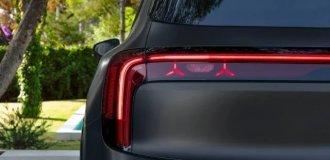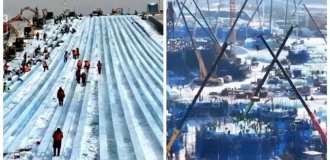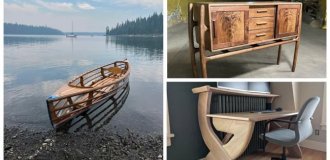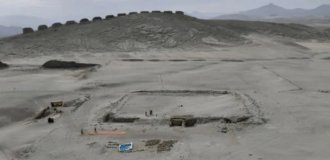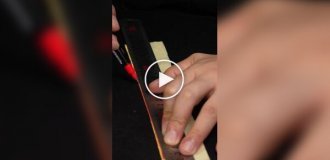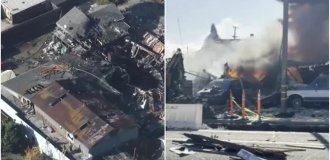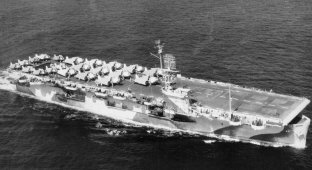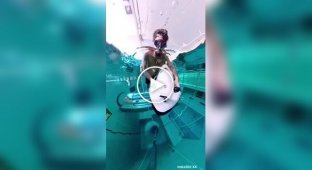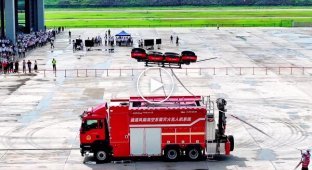The "Old Lady" Who Survived the War The History of the Aircraft Carrier USS Saratoga (6 photos)
World War I determined the development of the navy, aviation, and other branches of the armed forces. In particular, ships and aircraft had many points of contact. One combination of these technologies led to the development of aircraft carriers. Some saw them as a waste of resources, but others began to look to the future "masters of the seas." 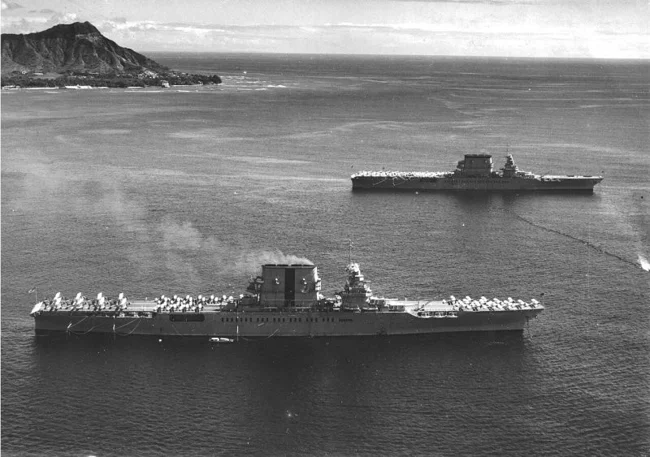
US Navy aircraft carriers USS Lexington and USS Saratoga in 1932
In the 1920s, naval development in the United States was in full swing. The idea of building aircraft carriers was also actively discussed in the highest circles of the Navy. All future aircraft carrier designs differed radically in size, speed, armor, number of aircraft carried, and other parameters. Simultaneously, preparations were underway for the largest international conference on the limitation of naval armaments, later known as the Washington Conference of 1921-1922. Following its conclusion, the five largest naval powers of the time pledged to adhere to restrictions on ship tonnage. In particular, the United States was required to scrap most of its battleships and battlecruisers under construction.
One of the developed aircraft carrier designs could easily have been implemented using ships already in production. However, a small problem arose: the Five Power Treaty also set the maximum permissible displacement for aircraft carriers—27,000 tons. The new design, with a displacement of 36,000 tons, was beyond the limit. After further consultations, the parties agreed on a limit of 33,000 tons, but this did not save the Americans: the ships still exceeded it. Taking advantage of the treaty's ambiguities, the US Navy command proposed excluding submarine and aircraft protection—anti-torpedo bulges and an armored deck—from the displacement. After these measures, the future aircraft carriers officially met the permissible limit.
In July 1922, the design was completed, and work on the new aircraft carriers began. The Americans decided to redesign two battlecruisers, named Lexington and Saratoga. Construction continued for several years, and the new ships entered service at the end of 1927. They were approximately 270 meters long, 32 meters wide, and had a draft of over 9 meters. Although the ships' basic displacement under the treaty was less than 33,000 tons, when accounting for the 3,000 tons not covered by the treaty and when fully loaded, it increased to 43,000. By the end of World War II, all of Saratoga's characteristics had increased so much that the carrier could no longer transit the Panama Canal.
The ship's protection consisted of an armor belt 127-178 mm thick and a main armor deck, which had two layers of 32 and 19 mm. Torpedo protection consisted of bulges and bulkheads up to 19 mm thick. The propulsion system was turboelectric. It included 16 boilers and four steam turbine generators, which supplied power to eight electric motors. This power plant allowed the ship to reach a maximum speed of 33.25 knots. Its maximum cruising range was approximately 10,000 nautical miles. The aircraft carrier's crew consisted of 2,800 people in peacetime and up to 3,300 in wartime. 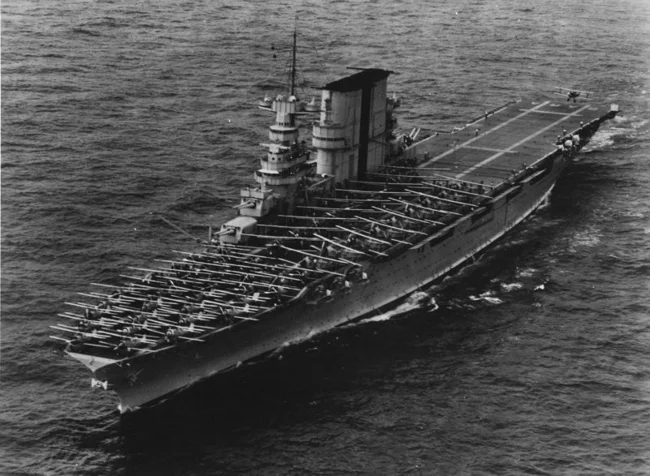
USS Saratoga in the summer of 1935
The primary armament of aircraft carriers is, without a doubt, their air groups. The design called for 78 aircraft on board, but in wartime, their number reached 109. The secondary armament consisted of four twin 203mm turrets mounted near the conning tower and twelve single 127mm guns. In 1942, a direct engagement between the carrier and enemy ships was deemed unlikely, so Saratoga's armament was modified. The 203mm turrets were replaced with dual-purpose twin 127mm mounts. The small-caliber anti-aircraft artillery was also enhanced: 12.7mm machine guns were replaced with additional 28mm quadruple automatic guns. In subsequent upgrades, the ship's anti-aircraft defense was provided by 40mm Bofors cannons and 20mm Oerlikon automatic guns.
Before the war, both aircraft carriers were the largest and fastest ships in the US Navy. Lexington and Saratoga served in the Pacific Ocean, regularly participating in maneuvers. In 1938, they conducted a series of exercises, executing a simulated attack on Pearl Harbor. Soon after, the Japanese fleet attacked the base under a similar scenario, marking the beginning of the war between the United States and the Empire of Japan.
The carriers' fates varied. In December 1941, Saratoga was in San Diego, replenishing her air group. At that time, it consisted of F4F-3 Wildcat fighters, SBD Dauntless dive bombers, and TBD Devastator torpedo bombers. When the carrier arrived at Pearl Harbor on December 15, reconstruction efforts following the Japanese attack were in full swing. The Battle of Wake Island was underway at the same time, and Saratoga sailed to the garrison's aid, but the atoll was captured before the ship could arrive.
In early 1942, the carrier was attacked by a Japanese submarine. One torpedo hit its target, flooding several boiler rooms. Repairs to the ship dragged on until the end of May. During this time, Japanese forces inflicted a number of defeats on Allied forces and advanced far south. In early May, Saratoga's sister ship, Lexington, was lost in the Coral Sea. The decisive Battle of Midway Atoll was approaching, but the aircraft carrier only arrived in the combat zone on June 6, failing to participate in the battle.
In late June 1942, the American fleet began preparations for the invasion of the Solomon Islands. Along with Saratoga, Enterprise and Wasp, which had arrived from the Atlantic, departed for the South Pacific. On August 7, 1942, American troops landed on Guadalcanal, beginning a months-long battle for the island. Fighters from Saratoga provided cover for the ground forces. The appearance of Japanese aircraft carriers was only a matter of time. This time, the Imperial Navy was able to deploy two heavy carriers, Shōkaku and Zuikaku, as well as the light carrier Ryūjō. On the morning of August 24, the opposing squadrons met near the Eastern Solomon Islands.
The Japanese made the first move in the battle. Aircraft from Ryūjō took off to bomb the American airfield on Guadalcanal. The Americans were able to locate the Japanese carrier, and Admiral Fletcher, the squadron commander, ordered an attack. For this purpose, 31 dive bombers and 8 torpedo bombers were launched from Saratoga. The Japanese ship was hit by 3 bombs and 1 torpedo, resulting in her being abandoned by her crew and sinking. In response, Japanese Admiral Nagumo launched squadrons from his heavy carriers. Neither American patrol fighters nor anti-aircraft fire could prevent the Japanese dive bombers from attacking Enterprise. The carrier was damaged and forced to leave the battle area. 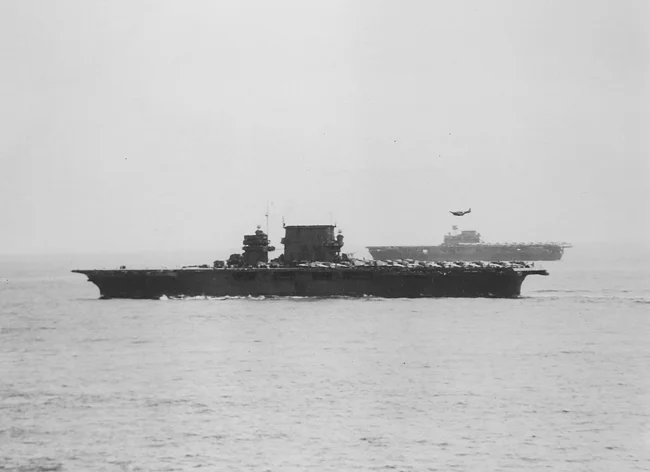
USS Saratoga and USS Enterprise in the South Pacific in 1942
Thus, only Saratoga and Wasp remained in this theater of operations, and not for long. On August 31, the American carrier force was attacked by a Japanese submarine. One of its torpedoes struck Saratoga in the stern. Although the damage seemed minor at first glance, a short circuit soon occurred, and the ship was unable to move. She was again forced to undergo repairs, which lasted until November 1942.
In early 1943, Saratoga returned to the South Pacific. At that point, only Enterprise was serving there, and reinforcing the carrier force was vital for the Americans. Their ground forces had won a crucial victory in the Battle of Guadalcanal, and it was time for Japan to go on the defensive. The Imperial Japanese Navy's carriers had also suffered heavy losses, especially in experienced pilots. Therefore, their heavy carriers were unable to engage the Americans, and the Japanese command did not dare to attack with only light carriers.
Soon, Enterprise underwent lengthy repairs, and Saratoga began preparations for offensive action. The US Navy temporarily received the British heavy carrier Victorious as reinforcements. Together with her, Saratoga supported the landings on New Georgia Island. Thus, the Americans gradually began to recapture the Solomon Islands from the Japanese. At the end of July, the Victorious departed for home. By then, new aircraft carriers had already begun to appear in the American fleet—the heavy Essex-class and the light Independence-class.
For almost all of 1943, the battle for the islands in the South Pacific raged. The Imperial Navy kept its battleships and carriers at home, while the brunt of the war fell on the shoulders of Japanese destroyers and cruisers. On November 1, the Battle of Bougainville began. The Japanese had no intention of giving it up and committed their cruiser forces to the battle. The Americans managed to repel the initial attack in the Battle of Empress Augusta Bay, but they realized the Japanese fleet would not stop there. It was decided to launch a preemptive strike on the Imperial Navy's forward base, Rabaul.
On November 5, Saratoga and the light carrier Princeton approached the target at close range and launched nearly 100 strike aircraft. Although the Japanese naval base was well defended from air attack, the appearance of American aircraft came as a surprise. Soon, the Japanese heavy cruisers Takao, Maya, and Mogami suffered direct bomb hits, while Atago, Chikuma, and the light carrier Agano suffered serious damage from nearby bombings. Thus, a single successful American carrier raid crippled most of the Japanese forces in the region. 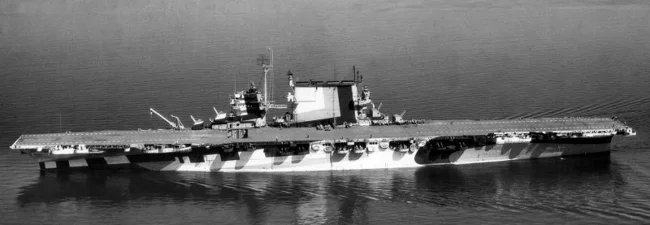
USS Saratoga in camouflage paint, 1944
1944 arrived. During its first months, Saratoga actively participated in the operation to capture the Marshall Islands, striking enemy ground targets. From mid-March, the carrier was again assigned to a team with its British counterpart. This time, it was the heavy aircraft carrier HMS Illustrious. The task force also included the British battleships Queen Elizabeth and Valiant, the battlecruiser Renown, and the French battleship Richelieu, along with six cruisers and 15 destroyers. There was no time to practice joint maneuvers, and on April 19, the Allied force launched its first attack on Japanese forces, attacking a base on Sabang Island. In May, another successful raid was launched on the city of Surabaya on the island of Java. At the end of May, the British began to build up their forces in the Indian Ocean, and the need for American assistance disappeared. The parting ceremony became a solemn ceremony. The British fleet formed a line and raised its flags, while the ships' crews lined up on the decks. The American carrier sailed the length of the line and, saluting the Allies, departed for home.
Saratoga spent the entire summer and part of the fall of 1944 in Bremerton, where she underwent scheduled repairs and modernization. Afterward, the carrier participated in pilot training for night flights. The ship returned to the fleet only in January 1945, at the beginning of the final stage of the war.
On February 19, American forces began landing on Iwo Jima. This small island was crucial for both sides, and the Japanese had no intention of surrendering it without a fight. The Japanese command organized an attempt to assist the garrison, conducting an operation with a "special attack force." On February 21, six kamikaze pilots attacked Saratoga. Within three minutes, three aircraft crashed into the ship, two more crashed nearby, managing to hit their target with bombs, and one was shot down on approach. The carrier was engulfed in flames, and water was leaking into the ship through a hole. Within an hour, all fires were under control, and a second attack by five enemy aircraft was more successfully repelled—only one of the Japanese pilots managed to hit the ship with a bomb. By evening, temporary repairs were completed, and Saratoga headed home. During this attack, 123 crew members were killed and another 192 were wounded. 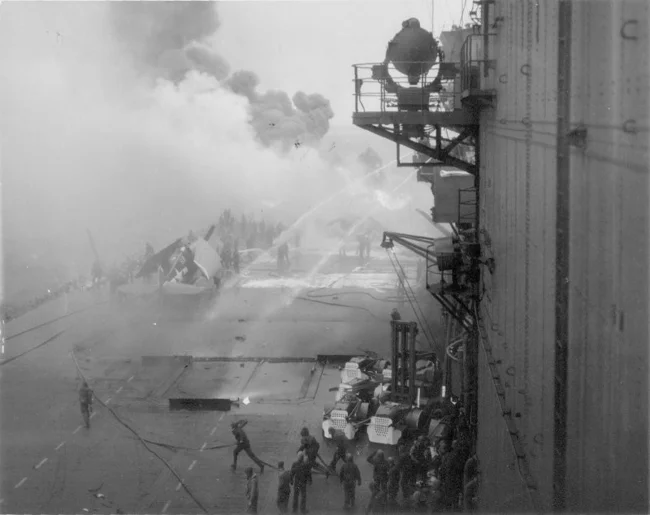
The deck of the USS Saratoga after the kamikaze attack
This marked the end of the carrier's combat service. She was first used as a training ship, and then for troop transport. To fulfill these roles, the aircraft hangars were converted into classrooms and living quarters. In 1946, command finally decided on the ship's fate. By then, work was actively underway to improve atomic weapons. The next tests were scheduled for July 1946. The chosen ships were mostly obsolete US fleet vessels, along with several captured German and Japanese ships. This operation was dubbed "Crossroads."
Saratoga was also chosen as a target ship. Its valuable equipment was stripped, leaving behind some fuel, ammunition, and a few aircraft on deck and in hangars. Data recording equipment was also installed on the carrier, and experimental animals were left behind. On July 1, an aerial detonation of a 23-kiloton atomic bomb occurred. Saratoga was located 2 kilometers from the epicenter. A flash of light caused the aircraft on the carrier's deck to catch fire, but the shock wave caused no serious damage. After the fire was extinguished, the commission confirmed the ship's suitability for the next test.
A second detonation, this time underwater, occurred on July 25. The bomb's yield was the same. This time, Saratoga was 408 meters from the epicenter, broadside to it. The blast wave knocked the funnel onto the deck and washed all the aircraft overboard. The ship's underwater section was severely damaged, and water began to enter the hull. Command ordered the aircraft carrier to be towed to shore, but this proved impossible due to high radiation levels. Eight hours after the explosion, the ship sank. Thus ended the story of the legendary aircraft carrier, one of only three in the US Navy to serve throughout World War II. 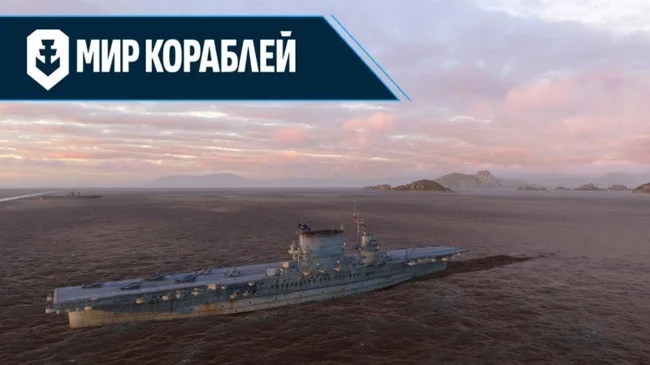
This material was prepared by the volunteer editorial staff of "World of Ships"

